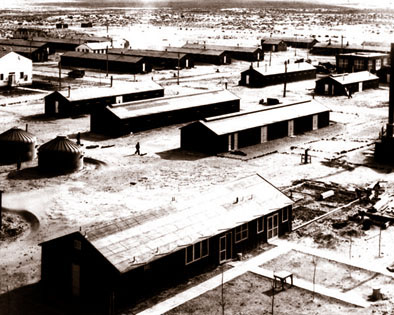- Homepage >
- Organization >
- History >
- 1950-1963
History 1950-1963
Soon after the Korean invasion, contracts were signed for additional construction at DPG. In January of 1951, the Chemical and Biological Warfare Divisions were activated at Dog Area. During 1952, construction of the Easy Area was completed and included the new post headquarters, barracks, dorms, schools and 300 Wherry housing units. In the same year, the Biological Warfare Division was moved from Dog Area to the newly constructed Baker Laboratory. On July 1, 1954, the Department of the Army confirmed DPG as a permanent installation (Pinkham and King, 1982). The Korean War ended in 1954, however the reactivation phase of construction at the base continued until 1963. At its population peak, in 1963, personnel and dependents at the base numbered 4,000.
DPG included analytical, biochemical, physical and organic laboratories. These laboratories supported the field activities through developing and strengthening existing methods of analysis for agents; studying the effects of toxic agents on enzymes and the identification and separation of constituents of high molecular weight in proteins and colloids; the development of new field samplers; and chemical synthetic work, and developing purification procedures for agents.

From 1953 to 1956 there was a BW laboratory at DPG which operated independently from DPG administration. In 1954, this laboratory was designated the Biological Warfare Assessment Laboratories and in 1956 the facility was returned to DPG and again became Baker Laboratory. The BW laboratory assessed field trials, developed field sampling devices, determined the relationships between the animal infections and the sampler devices results, studied virulence stability and organism decay and developed "assembly-line" methods for assessing virulence (cell count) by test tube or spectrographic means.
The radiological warfare laboratories were located at the Able Area and were primarily used during this period to study dosimetry (measuring doses of X-ray) and radiation of food. The food radiation program was conducted for the Quartermaster Food and Container Institute. The program was begun in 1954 by the University of Utah (as a contractor to DPG) and involved researching the preservation of food using "atomic bullets." The project used spent fuel elements from the Atomic Energy Commission to irradiate fresh, cooked, canned and prepared foods with gamma rays in an effort to kill micro-organisms, trichina in pork, and food-infesting insects.
For a more detailed look at the history of Dugway Proving Ground, see the links below.
HISTORY  1800-1942
1800-1942  1942-1945
1942-1945  1945-1950
1945-1950  1950-1963
1950-1963  1963-1972
1963-1972  1972-1989
1972-1989
